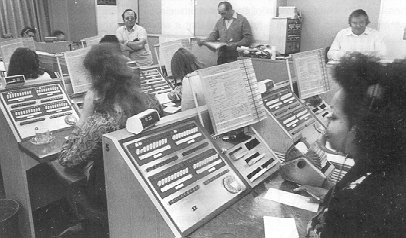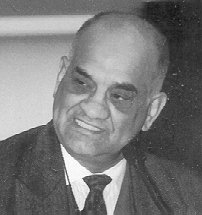| Steve
Shaller Remembers ODRTS and the "Animals" ...! |
|
During the mid-1980's ODRTS - still on voice - had terrible problems with
a small group who constantly interfered with transmissions by shouting and
swearing. They became known as "Animals" and it was left to the Board
of the late Chairman Peter Fennymore to work with a select group who became
known as "Trackers." Their story has never been told until now...
Looking at the state-of-the-art terminal in my cab, I cannot help but think
of those earlier days when "Lords" (now Dial-a-Cab) began life in the
humble neighbourhood of Shirland Road and the traumas that the-then BoM had to
weather as it learned to spread its wings.
As one of a team of 'trackers', our present data despatch system
brings back many bitter-sweet memories. Long standing members will know exactly
what I'm talking about, but for the benefit of the newer members of the
Society, let me give you a résumé.
I joined the Society in the late seventies when our offices were
at Shirland Road W9 and all the work was dispatched from the basement. We were
the Owner Drivers Radio Taxi Service (ODRTS), but known as 'Lords' because of
our telephone dialling prefix. We were also called the Gentleman's Circuit (and
I believe we still are). This was indeed a humble beginning. Business then was,
compared to today's standard, more leisurely and less sophisticated. Looking
back, it was laughable that three drivers would accompany the Society Secretary
to the bank to draw out money to pay the drivers for the account work they had
covered! Surely, nothing could be more basic and naive than this practice.
All the work was dispatched on voice and this gave any 'animals'
every opportunity to run wild. Animals were those cab drivers who, for whatever
reason, felt they had to get even with the dispatcher and their idea of getting
even was to hinder and harass the dispatcher making his life hell. Into the
bargain of course, the work inevitably suffered.
What methods did these animals used for badgering the dispatchers?
Hurling abuse was common practice, but playing music or using the transmission
button as a Morse code key were others. Imitating the voice of another driver
to cover a job no one wanted was easily the most moronic. "A100, how long
to pick up," the dispatcher would ask? Of course, A100 was at home, fast
asleep in bed as he had worked a long day! These are just a few examples of
what the dispatchers had to contend with.
Dispatchers, in an attempt to get the work out, would sometimes
keep changing channels. At other times, they would allocate the job to the
first call sign they received. With voice dispatch, when more than one mobile
transmitted simultaneously, a 'carrier' wouldone mobile transmitted
simultaneously, a 'carrier' would
|

In the basement of Shirland Road
|
come in with an ear-shattering screeching sound
- not very pleasant for the unfortunate dispatcher.
It was Brian Gillett (A71 and now retired) who came up with
an idea how we could control this situation and he approached the BoM with
it. He got Board Member, Aubrey Siteman, to drive away in his cab to any
place he chose and to hide himself. Aubrey was to keep his transmission
button engaged and read a newspaper loudly at the same time - just as the
animals did when they played about. To Aubrey's surprise, Brian had
tracked his whereabouts within minutes.
"Gotcha!" said Brian to a drop-jawed Aubrey! Aubrey
had been hiding in Elnathan Mews W9. After this successful demonstration,
the BoM gave the go-ahead for a tracking team.
To be a tracker, a member had to be prepared to drive many
miles - sometimes on a wild goose chase - must never have met the
Complaints Officer in his official capacity and generally have been a good
son to his mother and father! It wasn't until I went into partnership in a
cab with Jery Craig (C3) that I joined the Tracking Team. I was one of
three trackers covering the night shift.
Brian Gillett got to work with his soldering gun and aided
and abetted by an on-site Pye engineer, the Lords Tracking Team had well
and truly arrived - and the animals suddenly became an endangered species!
We didn't hunt them with elephant guns or pith helmets, but
with technology. The tracking
equipment was simple and effective. Our cabs were fitted with additional
radio receivers, which in turn were fitted with the same receiving
crystals as that in the Control Room, thus enabling us to hear the other
mobiles. In addition, a meter that measured signal strength was also
fitted enabling us to gauge the distance of the offending cab. We also
compiled listings of dates, times and locations of disruptions and it
wasn't long before we had a comprehensive list of cab registration numbers
and call signs. It was no coincidence how the same call signs kept
cropping up...
Once a month, we'd have a meeting at Shirland Road with a
Board Member in attendance. The idea was that the BM would report back to
the Board the progress we had made and for any special requests that we
had.
All trackers were allocated a
|

Sid Nathan (k88)
'99' call sign, so that when the dispatcher was talking to a 99 cab, the
other trackers would know that he had a problem with an animal. When the
dispatcher was getting 'stick', we would ask him to call an airport from a
point where we suspected the animal was holed up. It was amazing how often
the animal would take the bait.
Most radio equipment picked up electrical interference giving
many cabs distinctive signals. You could, with experience, identify a call
sign by the whine emitted from an alternator. Microphones had different
pitch sounds and you could even distinguish between a manual or an automatic
cab as the interference rose and fell in tandem with the gear changes. We
also found that flags and ribbons attached to aerials would cause a
fluttering signal as the wind hit the aerial!
At our request, a dispatcher would deliberately ignore a
suspected call sign when he bid for a job and then, when the driver
complained, he was told he must have a fault with his radio and to get it
changed. When the driver came in to have his radio changed, a special radio
that emitted a double tone signal would be fitted to his cab. After that,
the first time any stick was accompanied by this double tone signal, the
driver was expelled that same day.
Our success was the result of immaculate teamwork and whilst I
did feel sorry when idiots got themselves expelled, I knew that was the way
it had to be.
On 16 February 1983, all members of the Tracking Team received
a letter from Chairman Peter Fennymore, acknowledging our input and
informing us that V.I. (Vehicle Identification) was now in use and the
trackers - just like the animals - were now history.
Looking at the technologically advanced terminal in my cab now,
I do know how true that is. Nevertheless, many memories of LORDS, learning
to walk, are still mint fresh in my mind.
Steve Shaller (R75)
|
|